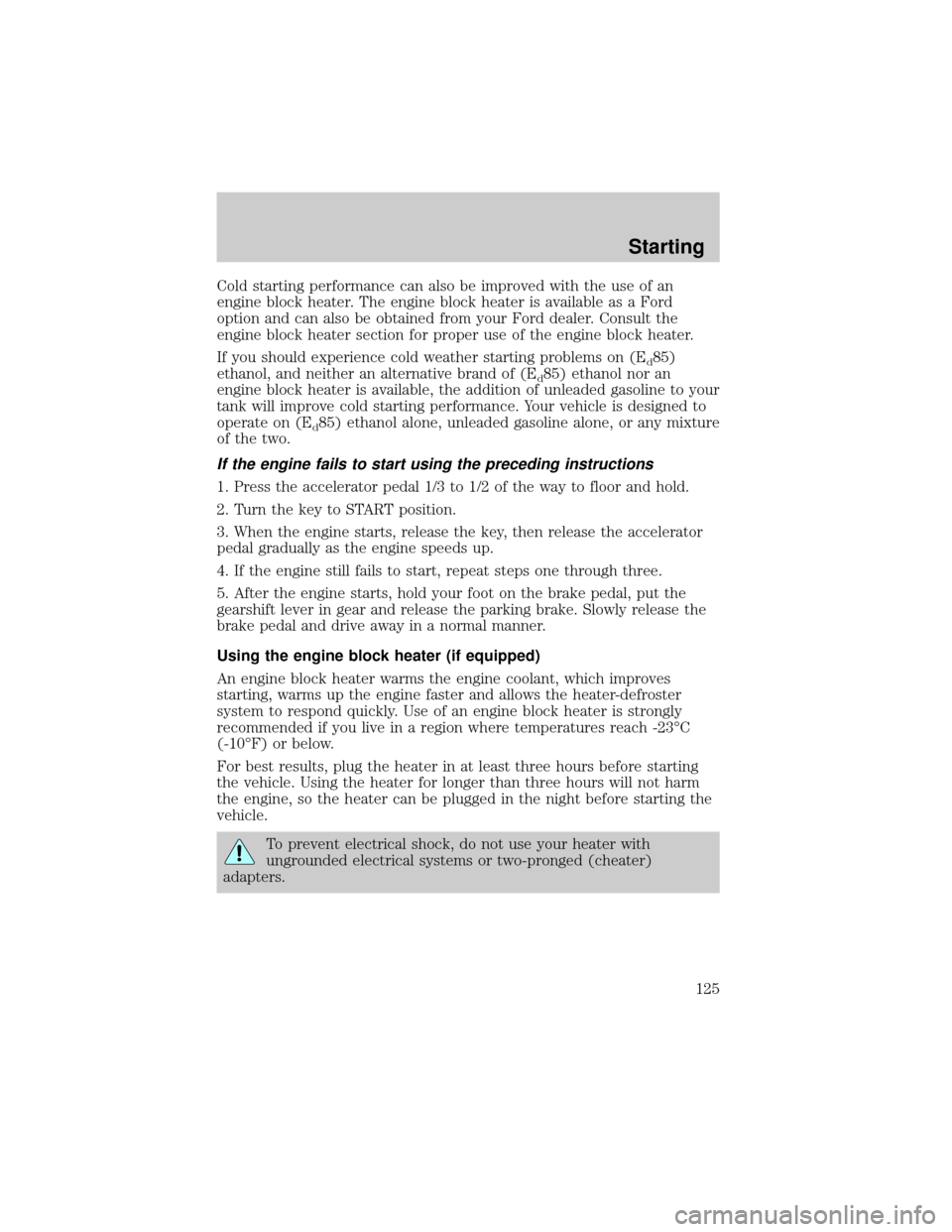2001 FORD TAURUS heater
[x] Cancel search: heaterPage 125 of 256

Cold starting performance can also be improved with the use of an
engine block heater. The engine block heater is available as a Ford
option and can also be obtained from your Ford dealer. Consult the
engine block heater section for proper use of the engine block heater.
If you should experience cold weather starting problems on (E
d85)
ethanol, and neither an alternative brand of (E
d85) ethanol nor an
engine block heater is available, the addition of unleaded gasoline to your
tank will improve cold starting performance. Your vehicle is designed to
operate on (E
d85) ethanol alone, unleaded gasoline alone, or any mixture
of the two.
If the engine fails to start using the preceding instructions
1. Press the accelerator pedal 1/3 to 1/2 of the way to floor and hold.
2. Turn the key to START position.
3. When the engine starts, release the key, then release the accelerator
pedal gradually as the engine speeds up.
4. If the engine still fails to start, repeat steps one through three.
5. After the engine starts, hold your foot on the brake pedal, put the
gearshift lever in gear and release the parking brake. Slowly release the
brake pedal and drive away in a normal manner.
Using the engine block heater (if equipped)
An engine block heater warms the engine coolant, which improves
starting, warms up the engine faster and allows the heater-defroster
system to respond quickly. Use of an engine block heater is strongly
recommended if you live in a region where temperatures reach -23ÉC
(-10ÉF) or below.
For best results, plug the heater in at least three hours before starting
the vehicle. Using the heater for longer than three hours will not harm
the engine, so the heater can be plugged in the night before starting the
vehicle.
To prevent electrical shock, do not use your heater with
ungrounded electrical systems or two-pronged (cheater)
adapters.
Starting
125
Page 149 of 256

Fuse/Relay
LocationFuse Amp
RatingPassenger Compartment Fuse Panel
Description
12 10A Heated Mirrors, Rear Defrost Switch
13 20A Power Point
14 Ð Not Used
15 30A Front Wiper Motor
16 15A Flasher and GEM Power, Integrated
Control Panel (ICP) Power, RCC Memory,
Cluster
17 15A Stop Lamp, Speed Control Deactivating
Switch
18 Ð Not Used
19 Ð Not Used
20 Ð Not Used
21 Ð Not Used
22 20A Deck Lid Release Solenoid, Lock/Unlock
Relays
23 10A Air Bag Module, PATS Transceiver
24 15A Transit Relay
25 2A PCM Relay
26 10A Mirrors, Power Antenna, Pulse Stretcher
Module, Deck Lid Lamp, Battery Saver
27 10A Gauges and Warning Lamps, Integrated
Control Panel (ICP), FFV Sender, GEM
28 10A Blower Motor Relay Coil, EATC Logic
29 15A Autolamps, Headlamp Switch
30 15A Horns and Horn Switch, OBD II Connector
31 Ð Not Used
32 10A ABS, DRL Relay Coil, Speed Control
Actuator, Traction Control Switch, AC
Heater Selector Switch, Blend Door
Actuator, Brake Shift Interlock
33 Ð Not Used
34 Ð Not Used
Roadside emergencies
149
Page 157 of 256

3. Park the booster vehicle close to the hood of the disabled vehicle
making sure the two vehiclesdo nottouch. Set the parking brake on
both vehicles and stay clear of the engine cooling fan and other moving
parts.
4. Check all battery terminals and remove any excessive corrosion before
you attach the battery cables. Ensure that vent caps are tight and level.
5. Turn the heater fan on in both vehicles to protect any electrical
surges. Turn all other accessories off.
Connecting the jumper cables
1. Connect the positive (+) booster cable to the positive (+) terminal of
the discharged battery.
Note:In the illustrations,lightning boltsare used to designate the
assisting (boosting) battery.
2. Connect the other end of the positive (+) cable to the positive (+)
terminal of the assisting battery.
+–+–
+–+–
Roadside emergencies
157
Page 239 of 256

Comfort and convenience
Air filtration
Cargo nets
Cargo organizers
Cargo shades (wagon)
Engine block heaters
Travel equipment
Electrochromic inside mirror with compass
Electrochromic inside mirror with compass and temperature
Factory luggage rack adaptors
Framed luggage carrier
Removable luggage rack
Removable luggage rack adapters
Soft luggage carrier
Speed control
Protection and appearance equipment
Car covers
Cargo liners
Carpet floor mats
Flat splash guards
Front end covers (full)
Molded splash guards
Rear decklid spoilers
Universal floor mats
For maximum vehicle performance, keep the following information in
mind when adding accessories or equipment to your vehicle:
²When adding accessories, equipment, passengers and luggage to your
vehicle, do not exceed the total weight capacity of the vehicle or of
the front or rear axle (GVWR or GAWR as indicated on the Safety
compliance certification label). Consult your dealer for specific weight
information.
Customer assistance
239
Page 245 of 256

idle speed control ...................185
lubrication
specifications ..................224, 226
refill capacities ........................223
service points ..................164±165
starting after a collision .........145
Engine block heater .................125
Engine oil ..................................166
checking and adding ..............166
dipstick ....................................166
filter, specifications ........168, 222
recommendations ...................168
refill capacities ........................223
specifications ..................224, 226
Exhaust fumes ..........................126
F
Flexible Fuel Vehicle (FFV) ....192
Floor mats ...................................65
Fluid capacities .........................223
Fuel ............................................192
calculating fuel economy .......199
cap .......................................9, 195
capacity ...................................223
choosing the right fuel ...........196
comparisons with EPA fuel
economy estimates .................202
detergent in fuel .....................198
filling your vehicle
with fuel ..................192, 195, 199
filter, specifications ........198, 222
fuel pump shut-off switch .....145
gauge .........................................16
improving fuel economy ........199
low fuel warning light ..............11
octane rating ...................196, 226
quality ......................................197
running out of fuel .................198safety information relating to
automotive fuels .....................192
Fuses ..................................147±148
G
Gas cap (see Fuel cap) ........9, 195
Gas mileage
(see Fuel economy) .................199
Gauges .........................................14
engine coolant temperature
gauge .........................................15
fuel gauge ..................................16
odometer ...................................16
speedometer .............................14
tachometer ................................15
trip odometer ............................16
GAWR (Gross Axle Weight
Rating) .......................................137
definition .................................137
driving with a heavy load ......137
location ....................................137
GVWR (Gross Vehicle Weight
Rating) .......................................137
calculating ...............................137
definition .................................137
driving with a heavy load ......137
location ....................................137
H
Hazard flashers .........................145
Head restraints ...........................84
Headlamps ...................................17
aiming ......................................214
autolamp system .......................18
bulb specifications ..................213
daytime running lights .............17
flash to pass ..............................17
Index
245